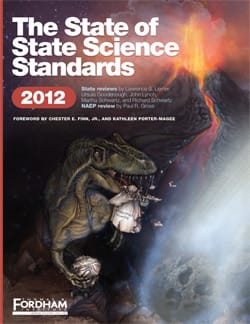 Since
Sputnik shot into orbit in 1957, Americans have considered science and
science education to be vital to our national security and economic
competitiveness. That imperative has continued
in the half century since the Soviet satellite launch. Indeed, a 2011
survey reports that 74 percent of Americans think STEM (Science, Technology,
Engineering, and Math) education is “very important,” while only two percent
say it’s “not too important.”
Since
Sputnik shot into orbit in 1957, Americans have considered science and
science education to be vital to our national security and economic
competitiveness. That imperative has continued
in the half century since the Soviet satellite launch. Indeed, a 2011
survey reports that 74 percent of Americans think STEM (Science, Technology,
Engineering, and Math) education is “very important,” while only two percent
say it’s “not too important.”
Yet this strong conviction has not translated into strong science achievement. The 2009 National Assessment of Educational Progress found barely one-third of U.S. fourth graders “proficient” in science, slipping to 30 percent in eighth grade, and a woeful 21 percent in twelfth. International comparisons are even more disheartening. The most recent PISA assessment, for example, showed American fifteen-year-olds ranking a mediocre twenty-third out of sixty-five countries.
Meanwhile, U.S. companies continue to send jobs overseas in no small part because they cannot find enough Americans with the requisite STEM skills and knowledge.
Add it up and you should be alarmed, very alarmed. Seems the United States does a great job of talking the talk about getting science education right but we’re a long way from walking the walk.
Why? How can it be that Americans have voiced so much concern about science education for such a long time yet made so little progress in delivering it? There are multiple explanations, starting with the blunt fact that few states and communities have taken concrete action to build world-class science programs into their K-12 schools. Without such programs in place to deliver the goods, our Sputnik-induced anxieties remain fully justified today and again tomorrow.
What does a world-class science-ed program consist of? Many elements, of course, but it begins by clearly establishing what well-educated youngsters need to learn about this multi-faceted domain of human knowledge. Which means the first crucial step is setting clear and rigorous academic standards for the schools—standards that not only articulate the critical content that students need to learn, but that also properly sequence and prioritize that content. In the light of such standards, teachers at every grade can clearly see where they should focus their time and attention to ensure that their pupils are on track toward college- and career-readiness. So can curriculum directors, textbook authors, and test developers.
Hence the urgency and timeliness of Fordham’s latest study: The State of State Science Standards 2012. It carefully analyzes the K-12 science standards currently in place in all fifty states and the District of Columbia, as well as the framework that undergirds NAEP’s science assessment.
The results of that analysis paint a fresh—but still bleak—picture. The standards in science were mediocre to awful in 2005 and—though most of them have been revised in the intervening years—today a majority of the states’ standards are still mediocre to awful. Indeed, the average grade across all states is—once again—an undistinguished C. (In fact, it’s a low C.) In twenty-seven jurisdictions, the science standards earn Ds or Fs.
Bad news, to be sure. But there could be a silver lining. For there are good examples, too. California and the District of Columbia have science standards robust enough to earn straight As from our expert reviewers. Four others—Indiana, Massachusetts, South Carolina, and Virginia—earn A-minuses, as does the NAEP framework. Seven more states earn grades in the B range. In other words, thirteen jurisdictions—barely 25 percent, fewer than in 2005—earn honors grades for setting clear, rigorous, and specific standards.
That means states with weak standards don’t have to start from scratch. They could, for example, copy California’s. They could model their standards on the NAEP framework. Or they could team up with other states to develop a new and rigorous set of content-rich 21st century science standards. (And then implement them in their classrooms!)
As everyone knows, in 2009, the Council of Chief State Schools Officers (CCSSO) and the National Governors Association (NGA) came together to build rigorous common standards for English language arts (ELA) and mathematics. The result of this effort was 2010’s “Common Core” standards for those two subjects. Fingers were crossed, but they turned out well: These standards are clearer and more rigorous than those in use in most states. And the assessment-development process needed to give traction to the Common Core is already underway.
Today, a similar push toward quality common standards for science is also underway. Twenty-six states have teamed up with Achieve to craft “Next Generation Science Standards” (NGSS). This group intends to do for science what the CCSSO and NGA did for ELA and math: create a coherent set of clear, rigorous, and specific expectations that states will have the option to adopt as their own.
We don’t know how they’ll turn out. (Rumor has it that a draft will be available for review within a few months—and we at Fordham are keen to review it.) But if they’re done well, they will provide a swell option for states that, left to their own devices, have repeatedly stumbled when it comes to science standards.
As we’ve repeatedly cautioned, even the finest of standards alone cannot yield outstanding academic achievement. Serious, orderly, relentless implementation is crucial. But without a destination worth reaching, the arduous journey is scarcely worth making. Ensuring that all 50 states have—and are really using—strong standards in science, as in other key subjects, is the essential place to start.

